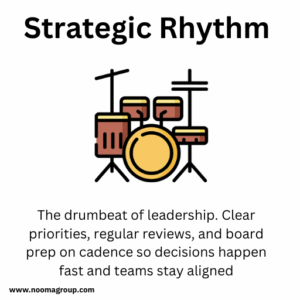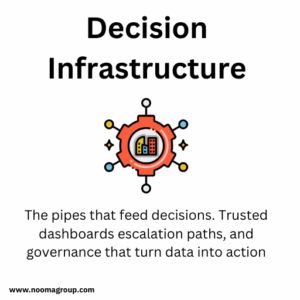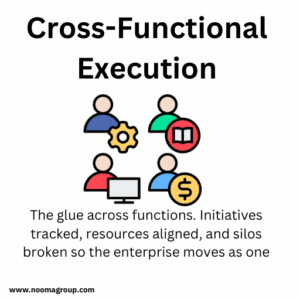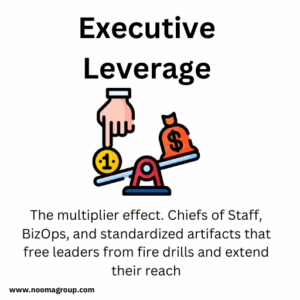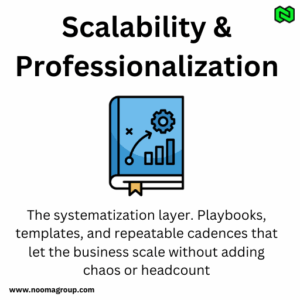Growth is good, but it’s stretching leadership thin. More bets on the table, more cross-functional handoffs, and more eyeballs from the steerco.
Then you see the signs of drag: decision latency, drift between teams, fire-drill prep, and priorities that multiply faster than outcomes. You feel the cost of coordination
What’s missing is a coordination layer. An operating system for the executive team: A way to turn strategy into a steady drumbeat and convert data into decisive action.
That’s what the Executive Operations (ExecOps) Framework delivers. It lays out five elements that keep leaders aligned, fast, and ROI-positive:
- Strategic Rhythm (the drumbeat)
- Decision Infrastructure (the pipes)
- Cross-Functional Execution (the glue)
- Executive Leverage (the multiplier)
- Scalability & Professionalization (systematization)
With this in place, you cut decision time, align initiatives to the P&L, free executive bandwidth, and scale leadership without adding chaos—or headcount. In short: ExecOps is how you scale yourself without burning out.

ExOps Operating Model
Strategic Rhythm
Roles and priorities multiply as you scale. Calendars fill up, reviews slip, and every review cycle turns into a scramble. Leaders feel busy, but not necessarily in control
That uncertainty is real: Cross-functional priorities lay dormant, decisions stack up, and the “urgent” stuff keeps shoving out the “important” stuff
If you dont have a steady drumbeat, you can never find your rhythm


Why It Matters
When there’s no shared cadence, teams default to local priorities. Decision latency goes up, cross-functional work stalls, and board prep becomes a fire drill. Finance operates on one clock, Product on another, and the executive story changes meeting to meeting.
You can’t allocate capital or people with confidence, and execution leaks between the cracks. Strategy-to-execution becomes luck, not design
Strategic Rhythm is the operating cadence that turns strategy into movement: OKRs and priorities on a single clock, WBR/MBR/QBR reviews that actually drive decisions, and board prep that runs as a process, not a panic. It’s how the leadership team stays aligned and decisive


In Practice
Set the clock: Lock the annual → quarterly → weekly review ladder (OKRs → QBRs → MBRs/WBRs) and publish the calendar a year out.
Start with priorities: 3–5 company priorities per year; cascade to quarterly objectives and weekly focus. Tie reviews to these, not to deck formats
Close the loop: Decisions feed dashboards and next agendas automatically; owners report back on outcomes, not activities
Payoff
With Strategic Rhythm in place, decisions get faster, priorities stay tight, and meetings produce actions. Board cycles become predictable, cross-functional work stops slipping, and executives win back calendar bandwidth to run the business

Download the full framework
Including definitions, examples, and case studies to put all five ExecOps elements into motion across your team; plus insights on common pitfalls, lessons from the field, and the benefits organizations see when they professionalize executive operations.
Decision Infrastructure
Data is everywhere, but decisions still stall. Dashboards don’t match, KPIs fight each other, and every big call triggers a hunt for “the real number.” Without trusted pipes and clear forums, signal gets buried in noise


Why It Matters
When facts aren’t trusted, leaders re-litigate basics instead of deciding. Decision latency climbs, cross-functional work stalls, and board/investor confidence takes a hit.
You can’t steer capital, people, or priorities with precision if the inputs are shaky
Decision Infrastructure is the pipework that turns metrics into action—gold-source data, a shared KPI language, refresh SLAs, alert thresholds, governance forums, and an audit trail—so executives can make fast, defensible calls


In Practice
Define the KPI Tree: Tie top-line goals to drivers (revenue, margin, CX, risk). Show how each metric rolls up
Publish the Metric Dictionary: Name, definition, calculation, gold source, owner, refresh SLA, and caveats. No shadow math
Alerting & Runbooks: Event-driven alerts (e.g., churn spike, margin dip) with “first 3 moves” documented
Payoff
You stop arguing about numbers and start deciding. Calls get faster, escalations get cleaner, and board reviews feel like confirmation vs discovery.
Trust increases, rework decreases, and the org moves with one version of truth

Download the full framework
Including definitions, examples, and case studies to put all five ExecOps elements into motion across your team; plus insights on common pitfalls, lessons from the field, and the benefits organizations see when they professionalize executive operations.
Crossfunctional Execution
Work crosses Finance, Product, Sales, Marketing, and HR but ownership doesn’t.
Plans make sense inside functions and fall apart in the handoffs. Everyone’s busy. Nothing moves as one
That friction is the tax you pay for growth, with the impact being leadership time spent refereeing instead of directing
Without orchestration, the cost of coordination eats your ROI.


Why It Matters
When cross-functional work isn’t managed as a system strategic bets die by a thousand “almost done’s.” Leaders lose line of sight, teams lose momentum, and the board loses patience
Enterprise value requires enterprise movement
Cross-Functional Execution is the glue: A shared initiative system, dependency-aware planning, and a review cadence that converts blockers into decisions so your org moves in formation
Cross-Functional Execution is the discipline of orchestrating initiatives that cut across silos. It aligns resources, tracks dependencies, and provides a cadence to surface blockers and make decisions.
Done right, it’s the glue that binds functions into one operating enterprise


In Practice
- Enterprise Initiative Register: Single source of truth for cross-functional bets with DRI, milestones, dependencies, and P&L linkage.
Cadenced Operating Reviews – Weekly run-the-business (KPIs/blockers) and bi-weekly change-the-business (initiatives/risks).
- Standard Initiative Brief – One-pager for every major initiative (objectives, scope, dependencies, required decisions).
Payoff
Throughput goes up, rework goes down, and initiatives land on time because owners, resources, and decisions stay synchronized
Leadership stops the turf warsand starts accelerating outcomes
The enterprise finally moves as one: Fewer meetings, faster progress, clearer ROI

Download the full framework
Including definitions, examples, and case studies to put all five ExecOps elements into motion across your team; plus insights on common pitfalls, lessons from the field, and the benefits organizations see when they professionalize executive operations.
Executive Leverage
Executives can’t scale on hustle alone. Before long, the leader’s day is a wall of fire drills. The work expands, but their reach doesn’t


Why It Matters
When everything routes through the top, leadership turns into triage. Strategic issues get buried under tactical noise. Fatigue sets in. The cost isn’t just burnout; it’s execution drag across the org.
Executive Leverage is how you flip the script. Chiefs of Staff, BizOps leads, and program managers absorb the chaos; standardized artifacts keep inputs clean; and inbound requests get filtered so the exec only touches what truly needs their call
It’s the multiplier that gives leaders back their groove


In Practice
Chief of Staff / BizOps Layer; operators who filter, prioritize, and package the work before it hits the exec’s desk.
Standardized Artifacts; decks, memos, and dashboards in tight templates so the signal is clear and decision-ready.
Executive Artifact Library; a stocked shelf of reusable one-pagers, slides, and dashboards that scale comms without reinvention.
Payoff
With leverage in place, leaders free up a third of their calendar. Fire drills shrink. Decisions get cleaner. Energy shifts from “What’s the next fire?” to “What’s the next bet?”
The executive stops being the bottleneck and starts being the amplifier.

Download the full framework
Including definitions, examples, and case studies to put all five ExecOps elements into motion across your team; plus insights on common pitfalls, lessons from the field, and the benefits organizations see when they professionalize executive operations.
Scaling & Professionalization
Growth loves to break the systems that got you here. What ran smooth at $100M starts grinding at $300M; by $600M, leadership feels like it’s carrying the company on its back. No playbooks, no groove; just duct tape and heroics


Why It Matters
When the basics aren’t professionalized, every cycle feels like déjà vu. Teams reinvent slides, chase numbers, and burn hours debating process.
Decisions take forever, onboarding is nonexistent, and leadership time gets swallowed by the small stuff. Scale without structure just multiplies the chaos
Scalability & Professionalization is the system layer. Playbooks, templates, and locked-in rhythms that turn leadership muscle memory into codified practice
It trims execution drag, shrinks the clarity gap, and gives you an operating model that can hold the weight of growth
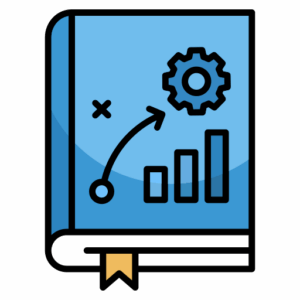

In Practice
Playbooks & Templates; cut the copy-paste chaos and give teams a starting point that works consistently
Cadence Calendar; a locked groove of reviews (weekly, monthly, quarterly) so decisions happen on schedule instead of by scramble
Operating Model Map; one blueprint that shows roles, cadences, governance forums, and KPIs so everyone runs off the same play
Payoff
With this layer in place, the business runs steadier. New hires ramp without guesswork; leadership cycles hum instead of stall; growth adds volume without adding drag
Leaders stop patching holes and start running the company on rails

Download the full framework
Including definitions, examples, and case studies to put all five ExecOps elements into motion across your team; plus insights on common pitfalls, lessons from the field, and the benefits organizations see when they professionalize executive operations.

